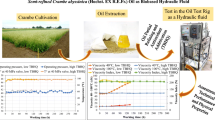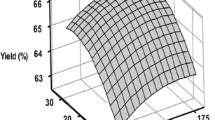Abstract
Process conditions of alkali refining, bleaching, and deodorization of crude chufa oil extracted from chufa (Cyperus esculentus L.) tubers grown in Korea were optimized to obtain an edible grade vegetable oil. The overall scope of refining conditions was similar to other vegetable oils. The degumming process, however, could be omitted since phospholipids were removed during alkalirefining and bleaching processes. RBD (alkali-refined, bleached, and deodorized) chufa oil fully satisfied Korean quality standards for edible vegetable oil. Chufa oil contained a high level of oleic acid, along with palmitic acid and linoleic acid. Physicochemical properties of chufa oil were similar to olive oil. The order of oxidative stability of chufa oil was crude>deodorized>degummed>refined>bleached oil. RBD chufa oil was virtually colorless and bland tasting, and was considered suitable for edible purposes.
Similar content being viewed by others
References
Ozcan MM, Gumuscu A, Er F, Arslan D, Ozkalp B. Chemical and fatty acid composition of Cyperus esculentus. Chem. Nat. Compd. 46: 276–277 (2010)
Sánchez-Zapata E, Fernández-López J, Pérez-Alvarez JA. Tiger Nut (Cyperus esculentus) commercialization: Health aspects, composition, properties, and food applications. Compr. Rev. Food Sci. F. 11: 366–377 (2012)
Arafat SM, Gaafar AM, Basuny AM, Nassef SL. Chufa tubers (Cyperus esculentus L.): As a new source of food. World Appl. Sci. J. 7: 151–156 (2009)
Coþkuner Y, Ercan R, Karababa E, Nazlýcan AN. Physical and chemical properties of chufa (Cyperus esculentus L.) tubers grown in the Ukurova region of Turkey. J. Sci. Food Agr. 82: 625–631 (2002)
Linssen JPH, Kielman GM, Cozijnsen JL, Pilnik W. Comparison of chufa and olive oils. Food Chem. 28: 279–285 (1988)
Oderinde RA, Tairu AO. Determination of the triglyceride, phospholipid and unsaponifiable fractions of yellow nutsedge tuber oil. Food Chem. 45: 279–282 (1992)
Lee SY, Jung MY, Yoon SH. Optimization of the refining process of camellia seed oil for edible purposes. Food Sci. Biotechnol. 23: 65–73 (2014)
Korea Rural Economy Institute, Food Supply Sheet 2012. KREI, Suwon, Korea. p. 233 (2013)
Duthie A, Patton S. Purification of phospholipids recovered from thin-layer chromatograms for infrared spectral analysis. J. Lipid Res. 6: 320–322 (1965)
Yoon SH, Kim SK. Oxidative stability of high fatty acid rice bran oil at different stages of refining. J. Am. Oil Chem. Soc. 71: 227–229 (1994)
Jung MY, Yoon SH, Min DB. Effects of processing steps on the contents of minor compounds and oxidation of soybean oil. J. Am. Oil Chem. Soc. 66: 118–120 (1989)
American Oil Chemists’ Society. Official Methods and Recommended Practices of the AOCS. 6th ed. Method Ca 12-55, Cd 3a-63, Tp 1a-64, Cd 1-25, Cd 3-25, Cd 8-53, Ce 2-66. AOCS, Champaign, IL, USA (2009)
Yoon Y, Choe E. Lipid oxidation and stability of tocopherols and phospholipids in soy-added fried products during storage in the dark. Food Sci. Biotechnol. 18: 356–361 (2009)
Farhoosh R, Moosavi SMR. Rancimat test for the assessment of used frying oils quality. J. Lipid Res. 14: 263–271 (2007)
Kim SK, Yoon SH, Kim CJ, Cheigh HS. Effect of oxalic and phosphoric acid on degumming of rice bran oil. Korean J. Food Sci. Technol. 17: 128–130 (1985)
Wiederman LH. Degumming, refining and bleaching soybean oil. J. Assoc. Off. Ana. Chem. 58: 159–166 (1981)
Alle DA. Refining. pp.137–167. In: Lipid Technology and Applications. Marcel Dekker, New York, NY, USA (1997)
Maza A, Ormsbee RA, Strecker LR. Effects of deodorization and steam refining parameters on finished oil quality. J. Assoc. Off. Ana. Chem. 69: 1003–1008 (1992)
Gumuskesen AS, Cakaloz T. Chemical and physical changes in cottonseed oil during deodorization. J. Assoc. Off. Ana. Chem. 69: 392–393 (1992)
Warner K, Frankel EN. Flavor stability of soybean oil based on induction periods for the formation of volatile compounds by gas chromatography. J. Am. Oil Chem. Soc. 62: 100–103 (1985)
Metrohm. Oxidation stability of oils and fats-Rancimat method. Application Bulletin 204/2 e.
Satue MT, Huang SW, Frankel EN. Effect of natural antioxidants in virgin olive oil on oxidative stability of refined, bleached, and deodorized olive oil. J. Am. Oil Chem. Soc. 72: 1131–1137 (1995)
Author information
Authors and Affiliations
Corresponding author
Rights and permissions
About this article
Cite this article
Yoon, S.H. Optimization of the refining process and oxidative stability of chufa (Cyperus esculentus L.) oil for edible purposes. Food Sci Biotechnol 25, 85–90 (2016). https://doi.org/10.1007/s10068-016-0012-z
Received:
Revised:
Accepted:
Published:
Issue Date:
DOI: https://doi.org/10.1007/s10068-016-0012-z




